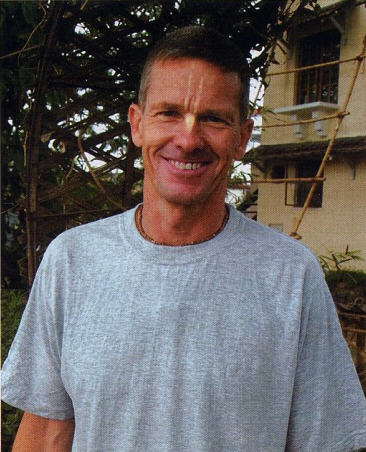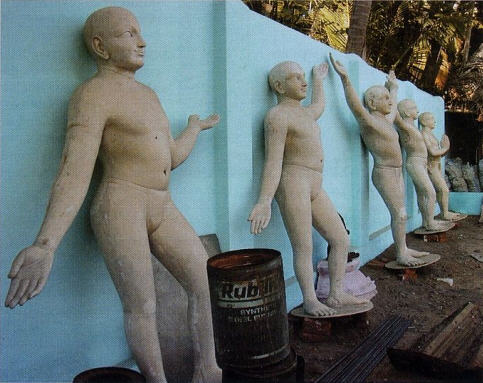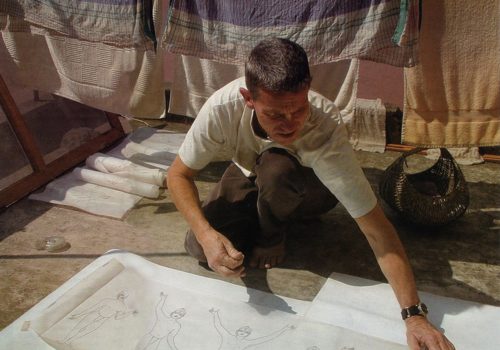A quiet, unassuming devotee from Australia has played a major role
in bringing the Panca-tattva deities to Mayapur.
As the preparations for the installation of Sri Sri Panca-tattva unfolded throughout the year, Mayapur was a hive of activity. The casting of the deities was the prime activity, and around that, other preparations began.

Bharata Maharaja Dasa
It's hard to track down Bharata Maharaja Dasa in Mayapur. He's usually at the temple construction site, but he may be elsewhere, attending to any of a thousand details that in the West would be called "small" but which in India assume gigantic proportions. Even after tracking him down, one finds that he doesn't have much to say. Mainly because he doesn't really have much time to stand around chatting, but really because he's just a very quiet bloke.
An unassuming Australian, Bharata Maharaja Dasa Bharata to the local devotees has lived in Mayapur for nearly sixteen years. He met the de-votees in Sydney, and joined ISKCON at the Colo River property north of Sydney in 1981 with his wife, Bhakta Gana Devi Dasi. Both qualified teachers, they were asked to take up service at New Govardhana, the farming community in the tropical northeast corner of New South Wales. The school was seeking both accreditation as a government-recognized school and funding to assist in its operation. Both were granted, and the school Bharata and Bhakta Gana stayed at New Govardhana until the end of 1988, when they came to Mayapur for the second time.
Samadhi Now

At that time, work on Srila Prabhupada's Samadhi (memorial) had come to a halt, but on Bharata's arrival, the work once again commenced. Bharata had been a potter with his own business in Australia, and one of the first things he did on his arrival was to build his own kiln and hand-fire all the sample terracotta panels that would grace the Samadhi walls. Initially the panels were to be plain terracotta, but soon another devotee, Matsya Avatara Dasa, became involved and introduced color. The result was Florentine-style multi-colored panels, and the work increased. Instead of requiring one firing, the panels required up to four. Consequently Bharata spent eight years instead of the proposed one year on the project, working under the most extreme conditions to complete this beautiful work of art.
At the end of it all, Yamuna Devi, one of Prabhupada's earliest disciples, laughingly said to Bharata, "Only eight years? I'm surprised it was so fast, under the circumstances!"
Such was the difficulty and arduous effort involved.
In 1995, shortly before the completion of the Samadhi, an artist named Milan Bagh, from the nearby town of Krishnagar, came to Mayapur and made the models for the small Panca-tattva deities that currently reside in the temple. Within three months, Bharata Maharaja had cast the deities in the workshop next to his house. In the middle of the casting, the workshop was pulled down and the artists and casters moved into Bharata's house. The work continued in the bedroom, while Bhakta Gana painted the completed deities in the kitchen. Sleeping bodies covered every available inch of floor by night, while work continued on the deities during the day. It was an austere living and working environment that lasted for three months, when the deities were finally ready.
The Clay Models
The deities were installed in 1996 for Prabhupada's Centennial year, on the last Ekadasi before Gaura Purnima. Shortly thereafter, Bharata Maharaja Dasa began working on the clay models for the large Panca-tattva deities. They were made on the roof of the Gada Building, a guesthouse on the grounds, high enough so the floods wouldn't threaten their work. Milan Bagh was again involved, working with Bharata in creating the models that would one day become the eight-foot-tall Panca-tattva deities. Before Milan joined the team, Bharata had tried making other models to test out different poses, but during a flood the models were ruined. After some time, the clay models were approved, and Bharata began work on the fiberglass models. When they were complete, no decision had yet been made as to the casting of the deities and their installment in the temple; the models stood on the verandah of Prabhupada's Samadhi for two years.
During this time, Bharata traveled with Bhakti Caru Swami, working as the art director on the Abhay Caran epic video series, traveling throughout Europe for eighteen months. As 1999 drew to a close, the deity models were still waiting on the verandah of the Samadhi.
Bharata returned to Australia with Bhakta Gana. He imagined that one day, on his return to Mayapur, he would see the deities on the altar. Krsna, it seems, had other plans.
Called to Duty
It was during his visit to Australia that Bharata received a letter from Jananivasa Dasa, the head pujari (priest) in Mayapur: "I really need someone like you to help me in the service of Sri Sri Radha-Madhava and the Panca-tattva. . . . I often think of you because you have a lot of practical experience. You also have good taste, and are a perfectionist."

The casting of the Panca-tattva deities in South India saw that perfectionism come to life. Bharata oversaw the entire operation, and carved the finer features into the faces of all five deities. The result has taken many years and the dedication of many devotees to produce.
"Manifesting the Panca-tattva deities was like having several cooks making a soup," Bharata says. "Over the years, many people added their own personal touches a bit of Bengali, a drop of New Zealander, a dash of South Indian, a splash of Armenian, a touch of American, a generous helping of old English transcendental vision, and a sprinkling of Italian sea-soning towards the end. My job was just to stir the pot from time to time and mix all these ingredients together."
Bharata Maharaja doesn't have much more to say than that.
"Nothing I say can add anything of significance. Now I just want to build a beautiful temple for the deities."
Few words, true, but Bharata's actions speak volumes, and the temple and deities are a testament to his artistry and eye for detail. The international community of devotees owes Bharata a debt of gratitude and respect for his service and dedication.
